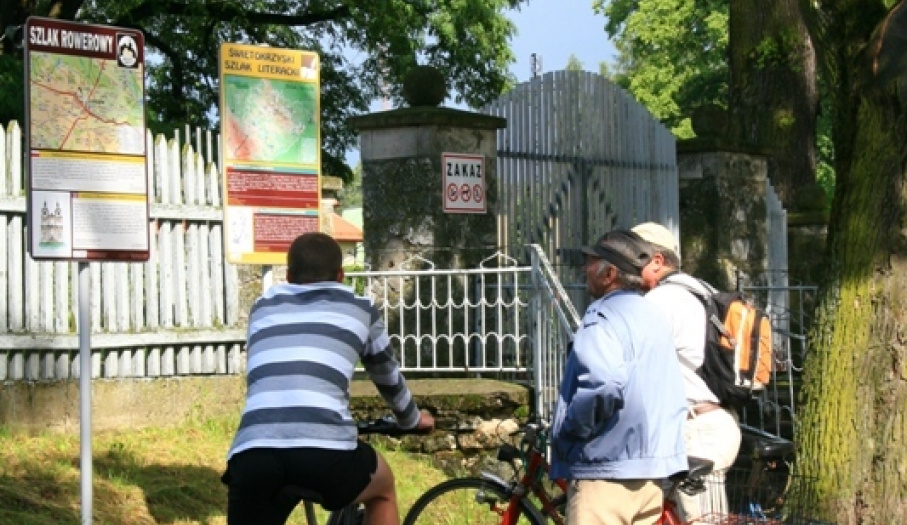Along the Trail of Spiritual Energy Sites
Practical Information
- Detailed InformationZwińRozwiń
- Object type:
- Bicycle
- Difficulty of the route:
- Intermediate
- Route route:
- Buskozdroj
- Jedrzejow
- Kielce
- Kielecki
- Sandomierz
- Skarzysko
- Wloszczowa
- Locations on the route:
- Kielce – Kielce Czarnów - Podzamcze Piekoszowskie - Piekoszów - Rykoszyn - Szewce – Zajączków - Bolmin - Małogoszcz – Mieronica – Rembieszyce - Lipnica – Sudół - Cierno Żabieniec – Warzyn I – Warzyn II – Rakoszyn – Nagłowice – Kossów – Dzierzgów –Czarna
- Organizer name:
- Regional Tourism Organization
- Organizer data:
- 25-033 Kielce, ul. Ściegiennego 2 32
- Phone:
- +48 41 348 00 60
- fax:
- +48 41 348 00 60
- E-mail:
- informacja@swietokrzyskie.travel
- Website:
- www.swietokrzyskie.travel
Description
Traveling along 600-kilometer-long yellow biking Trail of the Spiritual Energy Sites is the best way of visiting the most interesting places of religious cult in the Świętokrzyski Region. A few days" biking trip would cover the whole trail that runs along a closed loop leading through the Świętokrzyskie voivodeship. It will take you to the most important places of religious cult, sanctuaries and other sacral objects such as the monastery on Święty Krzyż, Golden Forest Hermitage in Rytwiany, collegiate church in Wiślica, Cistercian abbey in Wąchock, Cathedral of the Holy Virgin Mary in Kielce, and to the Sanctuary of Our Lady of Sorrows, Queen of Poland and Mother of the Świętokrzyski Region in Kałków-Godów. It"s only a choice from many other places of religious cult that are located on the Trail of Spiritual Energy Sites.
Course: Kielce – Kielce Czarnów - Podzamcze Piekoszowskie - Piekoszów - Rykoszyn - Szewce – Zajączków - Bolmin - Małogoszcz – Mieronica – Rembieszyce - Lipnica – Sudół - Cierno Żabieniec – Warzyn I – Warzyn II – Rakoszyn – Nagłowice – Kossów – Dzierzgów –Czarna – Wymysłów –Włoszczowa – Oleszno – Słupia – Radoszyce – Jacentów – Stary Dziebałtów – Nowy Dziebałtów – Sielpia Wielka – Piekło – Wąsosz – Czarniecka Góra – Stąporków – Świerczów - Bliżyn – Skarżysko Kamienna – Michałów – Marcinów – Wąchock – ratuje – Wykus – Radkowice – Rzepin I – Rzepin II – Kałków – Cząstków – Podchełmie – Stara Słupia – Nowa Słupia – Jeleniów – Wiórków – Komorniki – Nowa Zbelutka – Stara Zbelutka – Radostów – Szumsko Kolonia – Pułaczów – Niedźwiedź – Wola Kiełczyńska – Bogoria – Jurkowice – Królewice – Gieraszowice – Sulisławice – osiek – Niekrasów – Strzegom – Szczeka - Rytwiany – Sichów Mały – Sydzyna – Wilkowa – Podlesie –Biskupice – Zborówek – Pacanów – Zborów – Solec Zdrój – Piasek Wielki – Strożyska – Szczerbaków – Wiślica – Sielec -Kobylniki – Skotniki Duże – Stara Zagość – Nowa Zagość – Chroberz – Młodzawy Małe - Młodzawy Duże – Skrzypiów – Pińczów – Włochy – Chruście – Chwałowice – Stawiany – Gołuchów – Włoszczowice – Piotrkowice – Maleszowa – Brody – Górki – Skrzelczyce – Radomiece I – Łabędziów – Morawica – Piaseczna Górka – Kuby Młyny – Marzysz Pierwszy – Suków – Mójcza – Wietrzenia – Domaszowice - Kielce
Lenght: 583 km
Colour: yellow
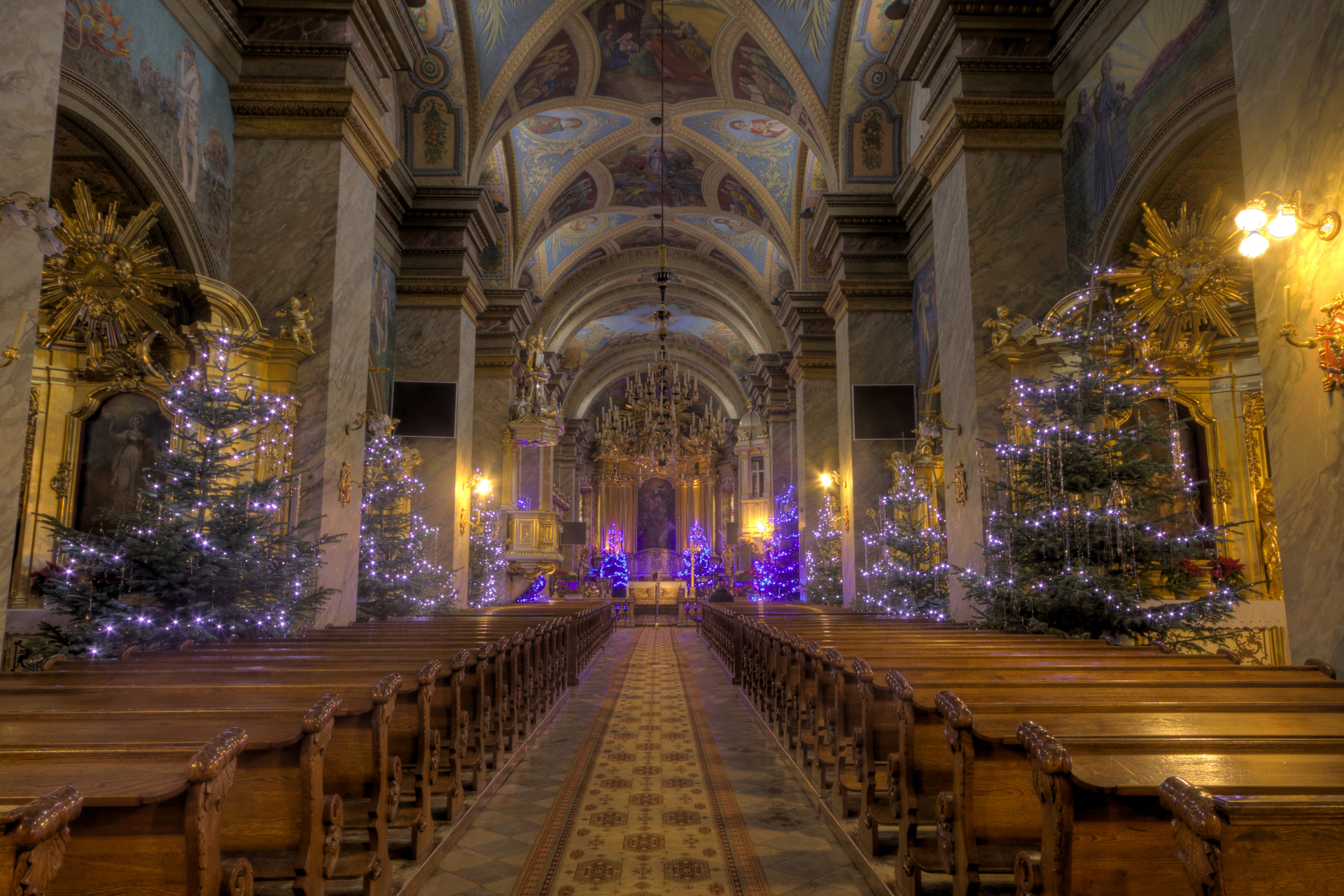 photo M. Maciążek
photo M. Maciążek Kielce – the Collegiate Church of the Holy Virgin Mary was founded by the Cracovian (Kraków) bishop Gedeon in 1171. It was erected on the Castle Hill in the very heart of the city. After many damages and reshapings, the present building represents an early-Baroque three-nave basilica with interiors sheltering the famous picture of Our Lady of Grace with Child, also known as the picture of of Our Lady of Grace of Kielce. It was painted around 1600. Placed in the southern side nave, the miraculous picture was crowned by Pope John Paul II on 3 June 1991. The cathedral treasury and the burial crypt of the Cracovian bishops is open to visitors.
Kielce Czarnów – medieval private manorial farm, presently the district of Kielce. Worth to see is Sanctuary of the God’s Mercy.
Podzamcze Piekoszowskie - this little village hosts ruins of the palace once belonging to the powerful Tarło family. Castellan Jan Tarło had an early-Baroque palace erected here in the years 1645-1650. It was patterned on the palace of Cracovian bishops in Kielce. Damaged by fire in the mid-19th century, the palace was never restored. Some windows still have their frames and four characteristic towers, once with spiral staircases inside, can be identified.
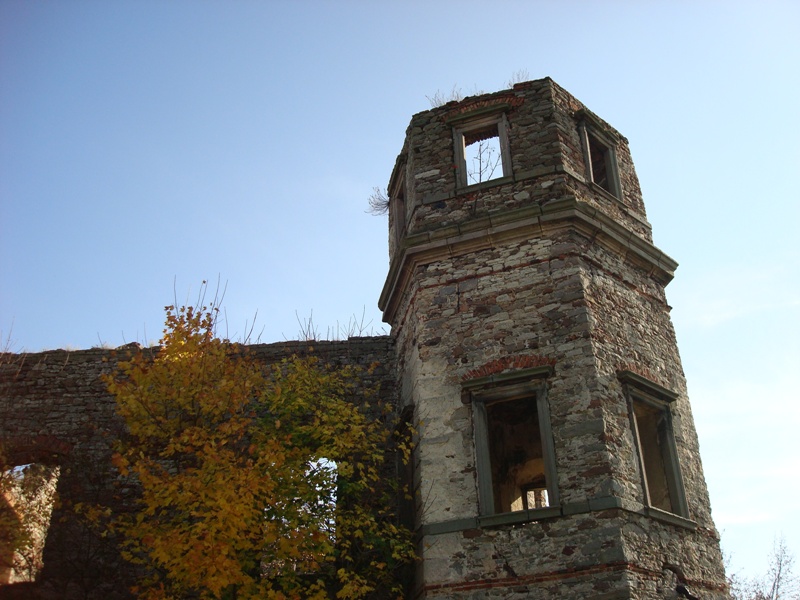
Piekoszów – the noble Odrowąż family had the first church dedicated to St James the Apostle built in Piekoszów in 1366. It became a local sanctuary thanks to the miraculous picture of Our Lady with Child painted by a Pauline monk from Częstochowa (Sanctuary of Black Madonna) in 1691. A bigger three-nave church was erected to meet the needs of the growing number of pilgrims. The picture was crowned by the Primate of Poland Cardinal Stefan Wyszyński in 1968. The crowns were stolen fifteen years later. The re-coronation ceremony took place in 1986 and was celebrated by the Primate of Poland Cardinal Józef Glemp.
Szewce – medieval servant settlement of the Chęcińskie property. During the Second World War, 17 September 1944 the battle of Domestic Army was taken place under captain Antoni “Szary” Heda command with Wermaht troops. Commemorative plaque and battle reconstruction remains this historical event.
Zajączków – one should notice water mill on the Wierna River near Zajączków and Ruda. During the 15 century the blast furnace functioned here.
Bolmin – the small village famous for church of The Blessed Virgin Mary from 1604 and ruins of the manor house erected at the turn of 16. and 17. century, rebuilt during the 19. and 20. century.
Małogoszcz –in the Middle Ages the town functioned as a castellany. Nowadays, one should notice church of the Assumption of The Blessed Virgin Mary (1591-1595), Renaissance presbytery erected at the turn of 16. and 17. century, cemetery church from 1595 and monument of Tadeusz Kościuszko.
Rembieszyce – one should notice larch church of Saints Piotr and Paweł built in 1798-1799 in baroque style. Painting of the Holy Virgin Mary with the Child from 17. century can be seen in the main altar.
Cierno Żabieniec – in the town one can see the church of Saint Marcin and Jakub, expanded in 18. century: two chapels with stuccoed decorations were added to the gothic presbytery. The southern chapel is decorated by Saint Mikołaj painting and northern one by Wincenty Kadłubek portrait.
Rakoszyn – the town is situated at The Timber Architecture Trail. One should notice church of Saint Stanisław the Bishop built in log construction in 18. century on the place of older one. Inside can be seen flat roof without polychromy and baroque altar with the painting of the Angelic Virgin Mary from 17. century.
 photo P. Pierściński
photo P. Pierściński Nagłowice - the Lusatian culture developed on this territory as far back as three thousand years ago. A burial ground with 86 graves from that time has been found during archaeological digs. However, the village of Nagłowice is commonly associated with “father of Polish literature” Mikołaj Rej. The Rej family of Oksza coat-of-arms took possession of the place in the 15th century and kept it for generations. In this region royal estates disappeared already in the early Middle Ages. Most of the land was owned by the Cistercian Abbey of Jędrzejów, but some villages got into hands of knights and parishes. Nagłowice belonged to the Lis family in the 14th century to be later passed into the possession of the Porajs and eventually the Rejs. Under skillful management of Mikołaj Rej the village and the surrounding estate flourished. There are still monumental oaks in the village that were supposedly planted by Mikołaj Rej himself. When the Walewski family took possession of Nagłowice in the 18th century, a new manor surrounded by a large and picturesque park were built. The magnate family of Radziwiłł were the last owners of Nagłowice. Prince Michał Radziwiłł had a palace erected adjacent to the manor built by the Walewskis. Now the manor of Nagłowice houses the Mikołaj Rej Museum.
Kossów - the town is situated at The Timber Architecture Trail. Worth to see is Częstochowska Holy Virgin Mary Church which is characterized by Gothic roof of Małopolski type. Probably, the altar originated from 1619. Timber belfry is situated at the cemetery.
Dzierzgów – one should notice church of The Assumption of the Holy Virgin Mary from 1903 which is famous for a picture possessing miraculous powers – Byzantine and Ukrainian painting of the Holy Virgin Mary with the Child from17 century, brought in 1651 after the battle of Beresteczko.
Czarna – in this village the Sanctuary of Holy Virgin Mary the Tutor is situated. According to the stories, Mary was appeared to the steel workers. Thanks to Izabela Małachowska’s effort, the church was built on this place. As a result of pilgrims movement, the new and bigger church was erected. The painting placed in the altar is perceived as one of the most beautiful portraits of the Holy Virgin Mary.
Włoszczowa - according to tradition, the church was to be built where Our Lady appeared to the children in the
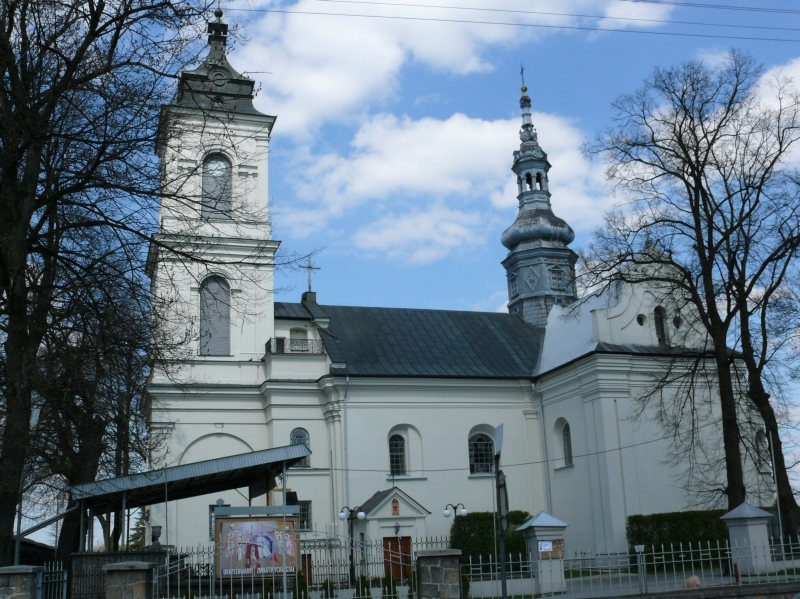 photo A. Suchanek
photo A. Suchanek 17th century. Primate Maciej Łubieński gave his consent for the construction of the chapel because the apparitions occurred many times and lots of people witnessed them. Some time later Father Jakub Chrostkiewicz brought a painting of Our Lady the Immaculate with Child from Cracow (Kraków). It is now placed in the high alter of the church which was greatly enlarged in the 19th century.
Oleszno – worth to see is early – baroque chuch of The Assumption of the Holy Virgin Mary from 17th century with baroque equipment and Niemojewski’s manor house from the end of 18. century
Radoszyce – the town was known as the royal property in Middle Ages. One should notice Saints Piotr and Paweł"s church which history went back to 1004 and Jewish heritage: synagogue, cemetery and ohel (small Jewish tomb)
Sielpia - situated on the Czarna Konecka River, near a lake of about 150 acres, is the biggest holiday resort in the Świętokrzyski Region. In the 19th century, however, the place was well known for the fact that one of the biggest industrial plants of Zagłębie Staropolskie operated there. Nowadays, the old buildings of the rolling mill and the puddling mill (a plant converting pig iron into malleable steel) house the Museum of Zagłębie Staropolskie. The most valuable exhibits include a huge, metal drive wheel of 8m diameter and some unique machines and equipment such as lathes, planning machines, presses or one hundred and fifty-year-old machine tools. Also, a water intake (dykes, sluices, and channels), production halls, wood dryers, a gate-house and an old settlement have remained there.
Piekło – the Hell Reserve is situated between Piekło (Hell) and Niebo (Heaven) villages. cluster of rocks with fantastic shapes has been protected. Rocks reach 5 meters and extend to a length of approximately 100 meters.
Czarniecka Góra – the village is famous for Świetokrzyskie Rehabilitation Center originated from 1891 when doctor Michał Misiewicz appreciated values of the neighborhood and bought just over ten hectares wood. In the early 20. century Czarniecka Góra acquired a spa status. “Stefan” pond enjoyed the most popularity among the visitors.
Stąporków – the name of the town derived from Stąpór – the owner, or special machines used to crumble the ore. Stąporków has become the capital of industrial complex at Czarna Konecka where the nail industry developed. The complex was destroyed during the Second World War. After renovation, the complex plant functioned until 50thies of 20. century. In the 70thies the local plant employed much more people than lived in the town. Stąporków has not historical monuments, instead of modern church of the Assumption of the Holy Virgin Mary.
Bliżyn – worth to see is the church of Saint Ludwik - stony three- nave basilica in Gothic Revival architecture style. Not far from here, the small larch church of Saint Zofia was erected. Moreover, Plater’s Palace named “Little Castle” is perceived as a historical building.
Skarżysko-Kamienna – patterned on the Vilnius Sanctuary of Our Lady, the one in Skarżysko-Kamienna is located near the road E77. Erected in the years 1986-93, it has a form of a square building with the chapel on the upper level. The chapel shelters a copy of the miraculous picture of Our Lady of Ostra Brama painted by Izabela Borowska from Vilnius. The picture was crowned on 2 July 2005. The construction of the sanctuary was generously sponsored by Poles living in Canada, England and the USA. It is often visited by pilgrims from those countries as well as Poles living in the East.Michałów – in the village the miller’s farmstead is perceived as a historical building. The “Piaska” mill was erected in the beginning of 20. century. At present, the building is adapted to the need of agrotourist farm.
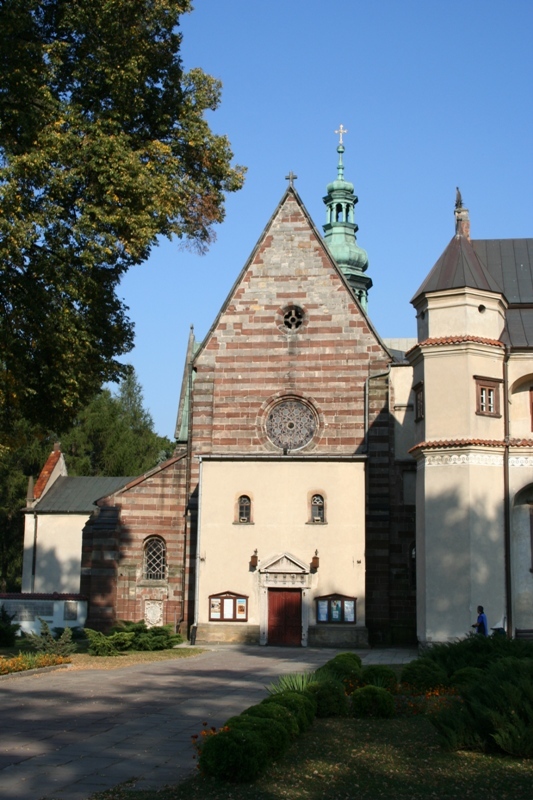 photo G. Szczęsny
photo G. Szczęsny Wąchock - not only jokes about Wąchock are known all over the country, but also its history closely connected with the existence of the Cistercian abbey built in the years 1218-1239. Remodeled many times, the complex features a monastery and a late-Romanesque church built of two-colored stone blocks. Its Baroque interior contains a Romanesque chapter house with cross-ribbed vaults and an early-Gothic refectory. The legendary commander of the Świętokrzyskie Home Army Groups major Jan Piwnik alias Ponury buried in the crypt located in the monastery cloisters. The Museum of Cistercian Fathers is situated next to the monastery gate and contains a unique collections of mementos from the national uprisings gathered by colonel Father Walenty Ślusarczyk. These collections are grouped in a few departments displaying variety of mementos devoted to Father Walenty Ślusarczyk, Commonwealth of Poland before Partitions, November Uprising (1830), January Uprising (1863-64), Second Polish Republic, World War II, and to the operations of the Home Army. The last part of the exhibition informs visitors about the history of the Cistercian Order in Poland.
Wykus- founded in 1978 reserve is located in the Sieradowicki Landscape Park. There are protected natural forest communities. Elevation (323 m n am) consisted of base Polish insurgents and guerrillas during the January Uprising (branches Mariana Langiewicza) and World War II (first under the command of Major Henryk Dobrzanski "Hubal", then John Piwnik "Grim"). Today, the turbulent history of this place provides a chapel with a painting of Sorrow, on the walls of which bear signs of pseudonyms and numerous graves of the fallen guerrilla in the woods around Wykus.
Radkowice - village is located on the Trail of Wooden Architecture because of the precious relic, which is the parish church of Holy Virgin Mary of Częstochowa. The church was built in timbered and consists of a square nave and a narrower presbytery. Roofs have the unique beauty. Neo-Gothic altar with a painting of Saint Antoni with the Child is located in the chapel. One should notice the windows from 17 century.
Kałków-Godów - although the youngest center of the Marian cult in Poland, the sanctuary is visited by a great
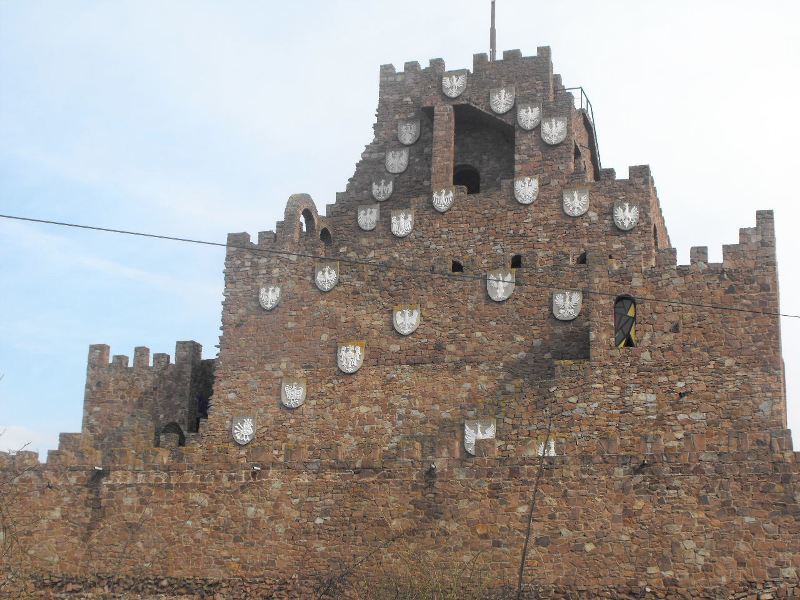 photo A. Kowalska
photo A. Kowalska number of tourists and pilgrims each year. This biggest regional pilgrimage center was created around the Sanctuary of Our Lady of Sorrows, Queen of Poland. It was started in 1967 thanks to the efforts of priest Czesław Wala and the support of the local people. In 1971 he bought an old stable in order to convert it first into a catechetic classroom, and later into a chapel. Today the area of 22 acres is dotted with different buildings, chapels, figures and the Way of the Cross stations. Behind the veil, in the high alter of the two-storied church is placed a miraculous picture of Our Lady, a copy of the famous picture of Our Lady of Licheń. The monumental building of the Świętokrzyska Golgotha, Pantheon of the Polish Nation Martyrology, is 33-meter-high and topped with a 15-meter-tall wooden cross. It was designed to imitate an old ruined castle.
Stara Słupia – the village is famous for the abbot’s Józef Niegolewski manor house from 1780.
Nowa Słupia - the area of the present Nowa Słupia was visited by pilgrims and merchants already in the 2nd century BC. Romans were coming to buy iron and pilgrims were heading for the summit of Mt Łysa Góra. The abbots from Święty Krzyż founded a town of Nowa Słupia in 1351. The new town obtained many privileges from king Władysław Jagiełło. It based its economy on services rendered to pilgrims. Dedicated to St Lawrence, the oldest parish church in Nowa Słupia was erected in 1678. Lateral naves and sacristy were added after World War II. Its interiors contain barrel vaults with late-Renaissance stucco works and Baroque side alters (18th c.) with paintings featuring Our Lady with the Infant and St Anne - Mother of the Holy Virgin Mary. Every year in August an archaeological festival known as Dymarki Świętokrzyskie is organized in Nowa Słupia in order to demonstrate visitors the ancient ways of smelting iron ore. Worth a visit is the Mieczysław Radwan Museum of Ancient Metallurgy.
Jeleniów – the town is derived from the Middle Ages. In Old-Polish times, the Arian’s church functioned here. Remains of manor complex did not preserved.
Bogoria – worth to see is church of the Holy Trinity from 18. century. In one-nave church with presbytery in the square plan and Saint Anna’s chapel, as the most beautiful is perceived barrel vault decorated with stucco, rococo equipment and late- renaissance, tiered tomb which belongs to the town’s owner and his wife.

Sulisławice - There two churches built in Sulisławice. The first one was erected in the 13th century, and although much enlarged in 1600, it preserved a few original Romanesque and Gothic elements such as builders" marks and the southern portal. The former sacristy now contains a memory room devoted to the Jędrusie partisan grouping that recorded the longest operation period during World War II. Next to the old church, a new one was built in the years 1871-1888. Dedicated to the Birth of the Holy Virgin, the new church is home to the much venerated picture of Our Lady of Sorrows of Sulisławice transferred from the old church. The picture painted in distemper on a wooden plank was most probably made around 1450.The first coronation took place in 1913. The gold crowns were stolen in 1940, but the robbers dumped them in the cemetery, where they were found later. The new crowns were consecrated on 7 July 1991 by Pope John Paul II during his fourth pilgrimage to Poland.
Osiek – the town is famous for Neoclassical Saint Stanisław’s church with late-Renaissance altar and gothic cemetery sculpture. Near Osiek, the sulphur sources are explored by unique method underground melting.
Niekrasów – the village is famous for larch church which consecration was conducted in 1661. The church was renovated and rebuilt many times. Nevertheless, the building is characterized by harmony and perfect proportions. The interior is equipped with Baroque decorations, however, the modest polychrome draws one’s attention.
Strzegom – worth to see is timber church erected at the turn of 16th and 17th century, however, it was rebuilt many times. Interior enchants witch the choir with organs, Baroque altar and very interesting architectonical detail – portal in the southern cloister with “donkey back” relief. The hundred years old belfry is situated next to the church.
Rytwiany - the Eremu Silvae Aureae, or the Golden Forest Hermitage, was built near Rytwiany (1624-27) for the
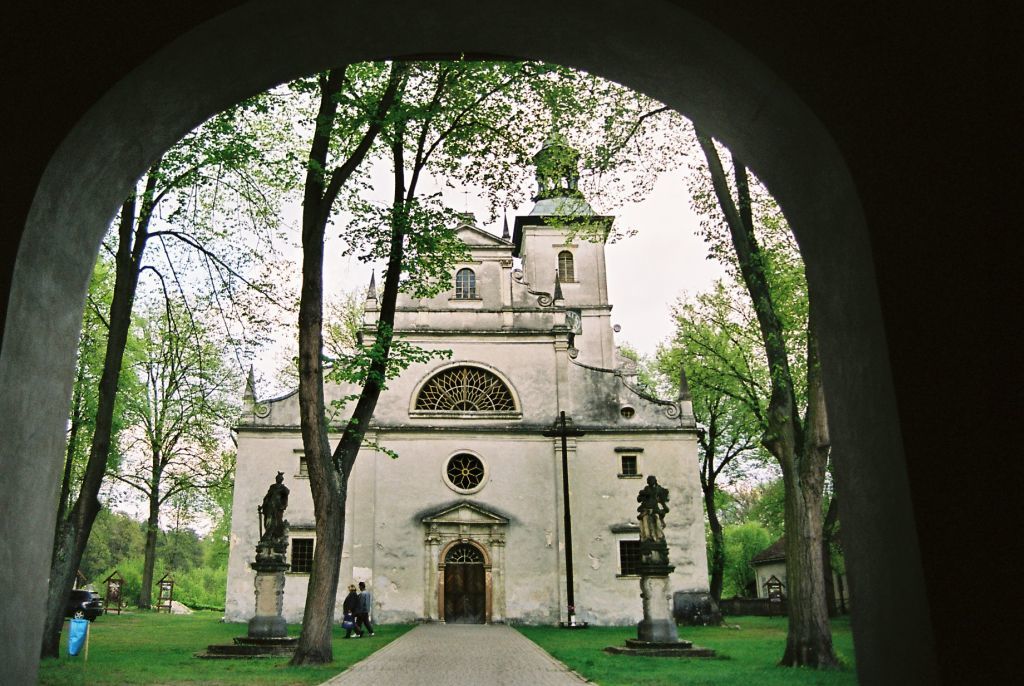 photo A. Drzewiecka
photo A. Drzewiecka Monte Korona Cameldolese congregation. The complex included a church of the Annunciation of the Holy Virgin Mary, monastic and administration buildings as well as ermitorium (16 dwellings for hermits). Today it is the only monastery opened to the public in Poland that has preserved its nearly original 17th century shape. It"s been a year now that the renovated Golden Forest Hermitage functions as a therapeutic center and offers therapeutic and relaxation stays to those who seek spiritual relief and wish to spend some time in silence, solitude, without radio, TV or telephone. The center can accommodate 40 persons in rooms with bath; there is also a fitness room, sauna and a massage center. In the refectory located in the main monastery building home-made dishes are served; they are prepared according to recipes of the European Cameldolese Trail.
Zborówek – in the village the timber church is perceived as the oldest timber sacral building in Poland. During the 20. century, a new bricked nave was added to the church and since hundred years the Neo-Romanesque nave and late-Gothic timber church as a presbytery have been functioning together as the whole temple. Worth to see is archway decorated with sculptures and polychrome from 18th century.
Pacanów - the oldest record that confirms the existence of the settlement and the neighboring villages is the foundation charter of St Martin"s Church in Pacanów issued by the Cracovian bishop Maur sometime between 1110-17. King Bolesław Wstydliwy granted Pacanów its municipal rights in 1279. Developing quickly during the 15th and 16th centuries, Pacanów attracted many craftsmen dealing in food processing and was the hometown of numerous clergymen who occupied eminent positions in church hierarchy. Worth to see is Saint Marcin Church. It stands in place of an original timber church consecrated in the early 12th century. Erected in the 13th century, the church was many times remodelled. Completely destroyed and pillaged in the 18th century, it was rebuilt at the end of the 19th century and reconsecrated in 1895. Turned into ruin during World War II, Staint Marcin"s Church was reconstructed again in the postwar period. The main nave with Saint Anna alter and the towers (1600) are the oldest parts of the building. It acquired the status of Basilica Minor in 2009. Worth to see is European Center of Fairy-Tales Pacanów never experienced so much fame as when writer Kornel Makuszyński created the town"s countrywide known celebrity – Koziołek Matołek (Billy-the Goat). Koziołek Matołek is the patron of the Festival of Children"s Culture that has been organized in Pacanów for some years now and attracts thousands of kids and adults as well. In the early months of 2010 the European Center of Fairy-Tales will open in Pacanów. It"s going to ba a place where children"s dreams shall come true.
Zborów – the Zborowski’s Family nest which at the end of the 16th century was property of the Tarnowski’s Family. The classical palace is the remain of this family. Two-storeyed palace hides in the basement the remains of original manor house. Presntly, the House of Caring is situated here. The complex consist of farm buildings and the park. The granary and distillery have survived to this day.
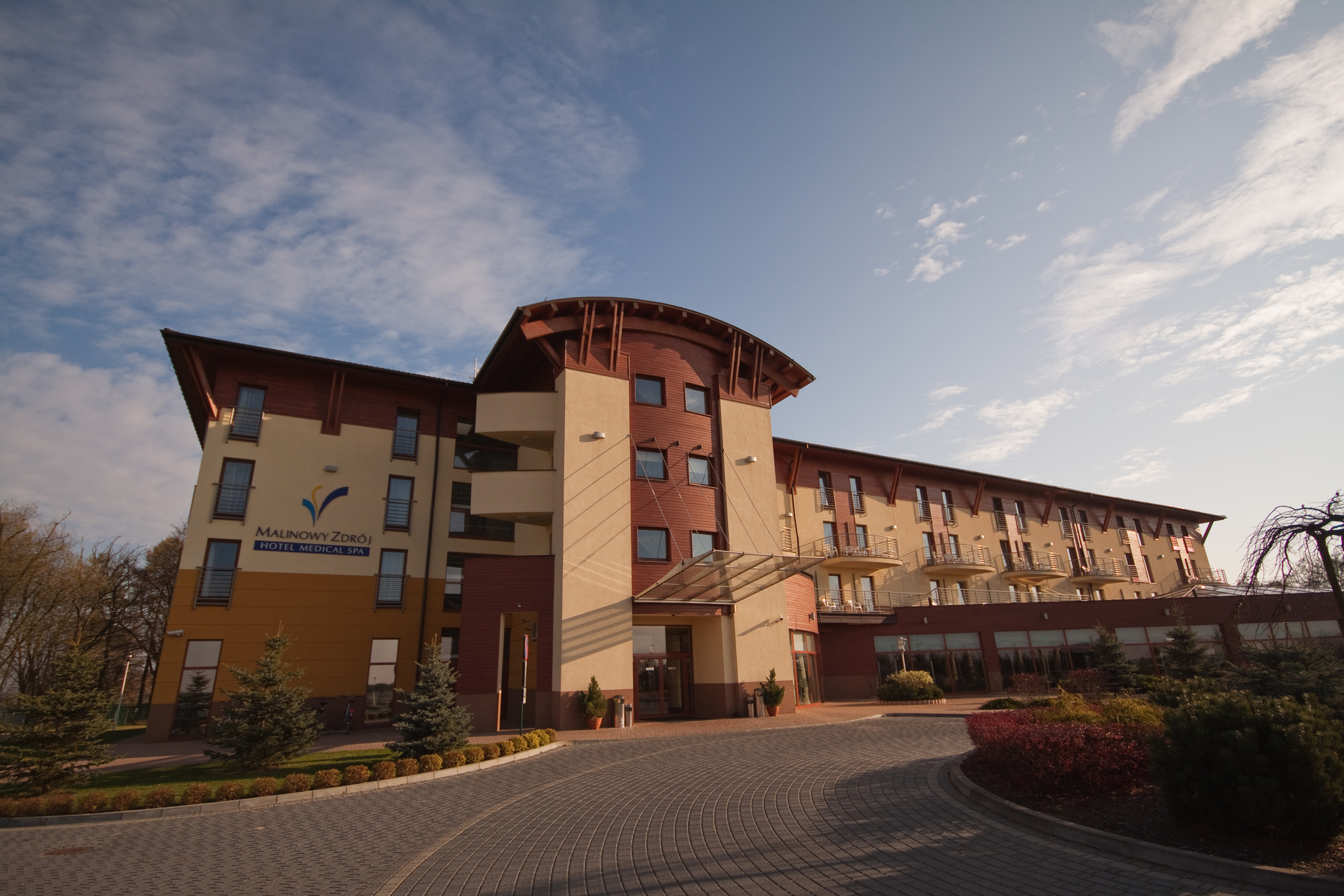 photo M. Maciążek
photo M. Maciążek Solec Zdrój – the most attractive buildings in the town belong to Health Resorts. Originated form the beginning of 20th century (“Świt” and “Jasna”, Willa “Prus” and “Irena”, neoclassical park and the main resort building) are famous for characteristic architecture. Worth to see is Saint Mikołaj’s church built in 1937 which refers to the circle Roman temples. The interior is decorated with Karol Godefoy’s, Ludwik Warchnowski’s and The Daniewski’s Family epitaphs. The most valuable monument is situated in the external part of the church – Mannerism tomb which shows sleeping knight - Samuel Zborowski. At present, Solec Zdrój is famous for Malinowy Zdrój SPA.
Strożyska – the village is famous for the All Saint’s church erected in 1378, founded by Michał from Strożyska. The church was rebuilt at the end of 19th century in gothic revival style. The nave from 16. century with square-planned tower are the most interesting complex in the whole church. Mentioned tower has the erected table engraved. Pseudo-nave interior is typical for Baryczkowska series which documented influence of Wiślicka collegiate on the building architecture.
Wiślica - The collegiate church in Wiślica was founded (14th c.) by king Kazimierz III Wielki (Casimir III the Great) as penance for the murder of Marcin Baryczko. The fact is commemorated on the erection plaque placed over the southern portal leading into the two-nave Gothic building. Remains of two earlier Romanesque churches (12th and 13th cc.) were discovered beneath the floor level, as well as a unique Orantów Plate, a Romanesque floor from 1170. The high alter shelters a Romanesque-Gothic stone figure of Our Lady with Child known as Madonna Łokietkowa (1300). It is believed that king Władysław Łokietek and other monarchs prayed here for graces and their prayers were not left without response. The ceremonious coronation of the picture was performed by the Primate of Poland Cardinal Stefan Wyszyński in 1966. Guided tours of the Basilica and the Museum are offered to visitors from Wednesday till Sunday between 9am and 4pm.
Skotniki Dolne – one should notice very interesting figure of Saint Florian.
Zagość – history of the village is connected with Order of Saint John (the German Protestant branch of the Knights Hospitaller, the oldest chivalric order, which probably was founded in Jerusalem in the year 1099). Saint Jan Baptist’s church was erected by Kazimierz the Great. Destroyed during the Swedish Deluge, rebuilt in 17th century . In the beginning of 20th century the western nave was added to the presbytery. Nowadays, there are few elements which draw one’s attention – Romanesque- Gothic presbytery and arcade frieze with mermaid relief which is connected with architecture of Lombardia.
Młodzawy Małe – built of the Pińczów limestone blocks, the Church of the Holy Spirit sits on a hill overlooking the
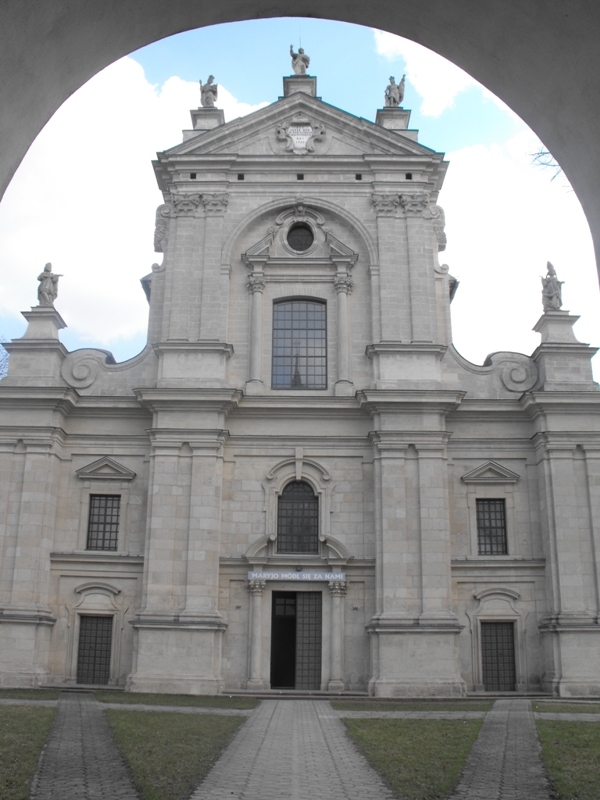 photo A. Kowalska
photo A. Kowalska Nida River valley. The site is often referred to as the Częstochowa of the Ponidzie Region. The monumental, late-Baroque temple contains the famous miraculous picture of Our Lady of Sorrows of Młodzawa from 1750. Under the presbytery and in the arms of the transept were placed the crypts of the church founders including margrave Aleksander Wielkopolski, Kępski family, and Józef Gonzaga-Myszkowski. The picture became referred to as miraculous after the following event: an intensive light was noticed in the church one day, and people thought that the church got on fire. The priest with parishioners went into the church and saw that all candles in front of the picture were lit. Nobody could do it because the church was locked. The same thing reoccurred three times, and ever since then the church has become a pilgrimage destination.
Skrzypiów – situated on the Pińczów – Wiślica way, Skrzypiów would never been present in the history if famous Polish writer, Jan Chryzostom Pasek did not live there. There are not any remains of Pasek’s manor house, however, the documents give many information about grange.
Pińczów – the monastery church of the Visitation of the Holy Virgin Mary was founded by the Myszkowski family in the 17th century. They also provided the church with a valuable painting of the Italian origin featuring Our Lady with Child. It was supposed to be a copy of the picture of Our Lady of the Snow from Rome, also known as Salus Populi Romani, or Salvation of the Roman People. Our Lady of Mirów has been venerated for centuries by pilgrims coming to Pińczów individually or in groups. The picture of Our Lady was crowned in 1992. Noteworthy is the rich ornamentation of the church interiors (barrel vaults with lunettes in the nave and presbytery) and the adjacent building of the monastery with cloister garth.
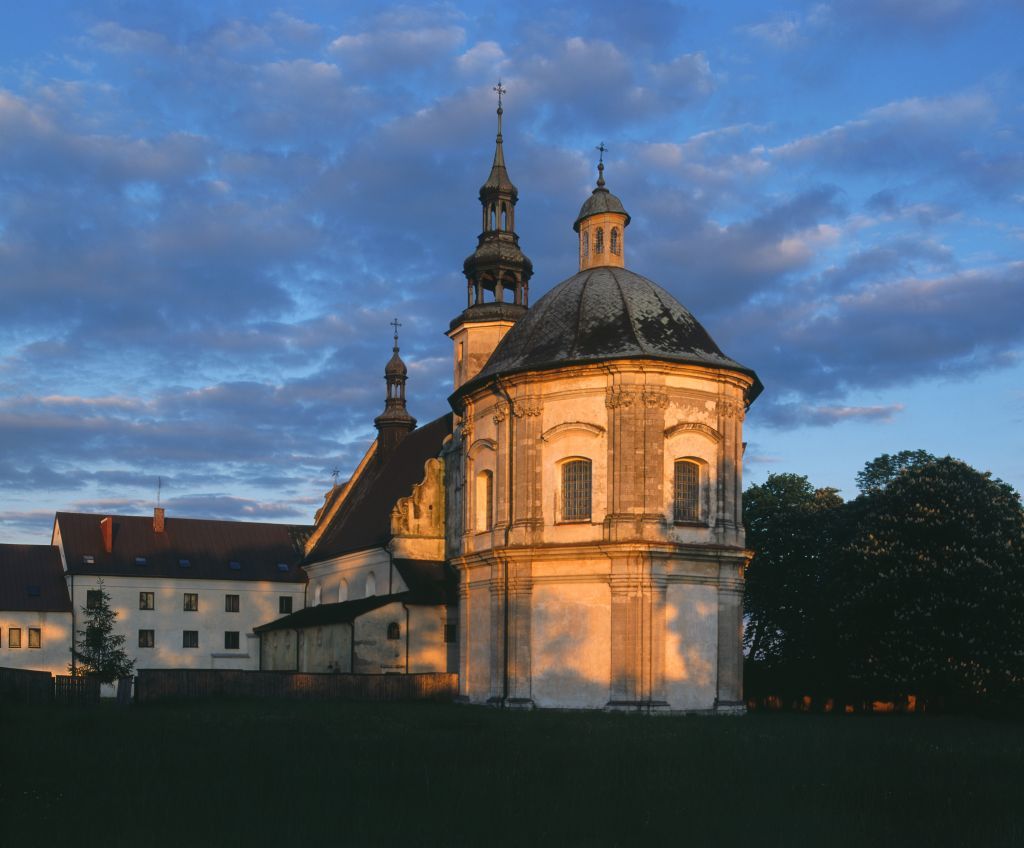 photo P. Pierściński
photo P. Pierściński Piotrkowice – it is a very popular pilgrimage destination already in the mid-17th century. People were coming to the Loreto Chapel located in the local parish church, where Our Lady of Loreto was venerated. The Gothic figure of Our Lady with Child dates back to 1400. The picture features Mary holding a scepter in her right hand; the Child sitting on his Mother"s left arm keeps his right hand on her shoulder and in its left hand holds an apple, a symbol of royal power. The Kielce bishop Czesław Kaczmarek put the crown over her head on 7 September 1958; it was the first coronation of Our Lady after World War II. Approximately 100,000 faithful attended the ceremony.
Maleszowa – one should notice ruins of the Krasicki residence. The manor house is well-preserved and belongs to the private person.
Morawica – the parish history is not more than several dozen years old. The Świętokrzyska Calvary was completed in 1997. It was built as a votive offering for the gift of John Paul II papacy. The Calvary is perfectly fitted into the church hill on which still stands the ruin of the old chapel dedicated to the Oraczewski family. The church was erected in the 1970s and contains the picture of Our Lady of Perpetual Care, an icon featuring Mary the Virgin, Infant Jesus, and Michael and Gabriel Archangels.
Mójcza – instead of reservoir, the timber church consecrated in 19th century is worth to see.
Wietrznia – was established in 1999 in the former quarry. One can see Devonian rocks profile with Devonian fauna fossils.
Domaszowice – in the village worth to see is chapel of Częstochowska Holy Virgin Mary from the second half of 19th century.

